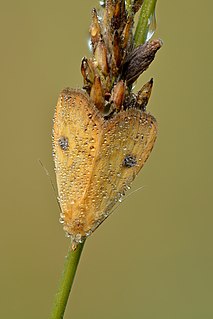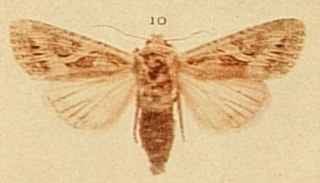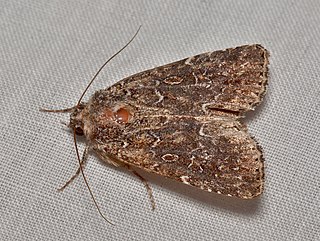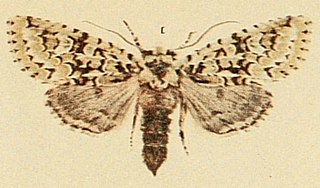
The poplar grey is a moth of the family Noctuidae. It is found throughout Europe.

Acronicta strigosa, the marsh dagger, is a moth of the family Noctuidae. It is distributed through most of Europe, east to the Caucasus, northern China, Korea and Japan.

Heliothis peltigera, also known as the bordered straw, is a species of moth of the family Noctuidae.

Caradrina kadenii, or Clancy's rustic, is a moth of the family Noctuidae. The species was first described by Christian Friedrich Freyer in 1836. It originates from southern and central Europe, Asia Minor and southern Russia but in the 21st century it has extended its range to the north.

Rivula sericealis, the straw dot, is a moth of the family Noctuidae. The species was first described by Giovanni Antonio Scopoli in his 1763 Entomologia Carniolica. It is found in Europe including the Iberian Peninsula and southern Fennoscandia and south to North Africa. In an easterly direction, the species occurs across the Palearctic to the Pacific Ocean and Japan. The species closely resembles Evergestis forficalis.

Conistra rubiginea, the dotted chestnut, is a moth of the family Noctuidae. The species was first described by Michael Denis and Ignaz Schiffermüller in 1775. It is distributed in Europe and, according to William Warren, Armenia and Asia Minor.

Minucia lunaris, the lunar double-stripe or brown underwing, is a species of moth in the family Erebidae. The species was first described by Michael Denis and Ignaz Schiffermüller in 1775 and is found in Asia, Europe and North Africa.

Xestia baja, the dotted clay, is a species of moth of the family Noctuidae. It is found in Europe, Turkey, northern Iran, Transcaucasia, the Caucasus, central Asia, Siberia, Mongolia, Tibet, China, Korea and Japan.

The green-brindled dot is a species of moth of the family Noctuidae. It is found in Southern Europe and the Middle East, then east up to Iran and Ukraine. In Germany it is found up to the Eifel and Ahr.

Lacanobia blenna, the stranger, is a moth of the family Noctuidae. The species was first described by Jacob Hübner in 1824. It is found in southern Europe, east to Turkmenistan.

Shargacucullia lychnitis, the striped lychnis is a moth of the family Noctuidae. It is found throughout most parts of Europe the Near East and Middle East.

Jodia croceago, the orange upperwing, is a moth of the family Noctuidae. The species was first described by Michael Denis and Ignaz Schiffermüller in 1775. It is found in southern and central Europe, to the north up to the southern half of England and Wales. According to Warren. W. in Seitz, A. Ed., 1914 also in Algeria, Asia Minor, and Armenia.

Actinotia polyodon, the purple cloud, is a moth of the family Noctuidae. It is found in much of the Palearctic realm, from Europe to Russia and Japan.

Condica capensis is a moth of the family Noctuidae. It is found across Africa, the Indian sub-continent and South-East Asia. In Europe, it is only common in southern Spain, but can be found further north.

Chloantha hyperici, the pale-shouldered cloud, is a moth of the family Noctuidae. It is found in southern Central Europe and from southern Europe to the Near East and Anatolia, Israel, Iraq, the Persian Gulf and the Caucasus, as well as northern Denmark, southern Sweden, southern Norway and south-western Finland.

Lithophane furcifera, the conformist, is a moth of the family Noctuidae. The species was first described by Johann Siegfried Hufnagel in 1766. It is found from central Europe, east to the Black Sea region, the Caucasus and western Siberia. In the mountains, it is found up to elevations of 1,800 meters.

Griposia aprilina, the merveille du jour, is a moth of the family Noctuidae. The species was first described by Carl Linnaeus in his 1758 10th edition of Systema Naturae. It ranges from Sardinia and south-east Russia from the southernmost part of Norway and Saint Petersburg through northern and central Europe to southern France and northern Italy, as well as in Castile. Also in western and central Anatolia and the Caucasus. Also in Asia minor. There is recent evidence from the Alborz mountain range.

Callopistria latreillei, Latreille's Latin, is a moth of the family Noctuidae. The species can be found in the Palearctic realm, most parts of Europe, Asia, and in Africa from Egypt to South Africa. The habitat consists of rocky limestone slopes with deciduous woodland.

Athetis hospes, or Porter's rustic, is a moth of the family Noctuidae which was described by Christian Friedrich Freyer in 1835. It is found in Spain, southern France, Italy, on the Balkan Peninsula, Crete, Turkey and northern Iran. The species seems to be expanding its range in north-western Europe with records from Great Britain and the Netherlands.

Eucarta amethystina is a moth in the family Noctuidae first described by Jacob Hübner in 1803. It is found in central Europe, east to Belarus, through the Ural to the Pacific Ocean.




















